Quantifying the Reflectance Anisotropy Effect on Albedo Retrieval from Remotely Sensed Observations Using Archetypal BRDFs
Abstract
:1. Introduction
2. Materials and Methods
2.1. Theoretical Basis
2.2. MODIS BRDF Product and Simulated Observations
2.3. Extraction of the Archetypal BRDF from the MODIS BRDF Product
2.4. Albedo from Prior BRDF and Limited Observations
2.5. Reflectance Anisotropy Effect
3. Results
3.1. BRDF Archetype and Validation
3.1.1. Archetypal Shortwave BRDFs
3.1.2. Accuracy Evaluation
3.2. BRDF Effect on Albedo Retrieval
3.2.1. Multi-Angular Observations
3.2.2. Single Observation
Lambertian Assumption
Albedo from Single Reflectance
4. Discussion
5. Conclusions
- (1)
- Six archetypal BRDFs are sufficient to summarize the reflectance anisotropy for quantifying the albedo retrievals in the shortwave band. The obtained archetypal BRDFs change from dome-shaped to bowl-shaped with increasing AFX values.
- (2)
- For the multi-angular observations used in this study, albedos retrieved from various archetypal BRDFs and sufficient observations agree well with the MODIS albedo. The relative uncertainty caused by reflectance anisotropy is <7.4%. The reflectance anisotropy effect on albedo retrieval from insufficient observations is markedly increased, with a relative uncertainty <16.2%. The inappropriate BRDF can introduce up to 14% and 35.9% relative uncertainties for sufficient and insufficient observations, respectively. The least RMSE method acquired a more accurate result with a relative uncertainty of approximately 13.4% at a solar zenith angle of 40°. The reflectance anisotropy effect on albedo retrieval is non-trivial when the solar zenith angle is less than 30°.
- (3)
- For the single directional reflectance, the Lambertian assumption could introduce a relative difference range from −40% to 50% for albedo values. If the inappropriate prior archetypal BRDF is used, the relative uncertainty can reach up to 38.3% in the albedo at the 40° solar zenith angle. Compared with the albedo retrieved from archetypal BRDF No. 3, the NDVI-based prior knowledge does not have any advantage in albedo retrieval, and the albedo of both methods has a relative uncertainty of approximately 11%. The relative uncertainty increased approximately 3–4% when the maximum random noise increased from 10% to 20%.
- (4)
- The intermediate archetypal BRDFs (No. 3 and 4) can enable a reasonably accurate (8–15%) estimation of surface albedo from insufficient multi-angular observations or single directional reflectance. Even if insufficient observations cannot provide adequate information and the directional reflectance shows a large difference from the MODIS albedo, the retrieved albedos based on archetypal BRDF No. 3 meet the requirements for use in climate studies. The albedo over tile h11v03 retrieved from a different directional reflectance and archetypal BRDF No. 3 is highly consistent with the MODIS albedo. The results indicate that this method is practical and effective for application to radiation budget studies, as many traditional satellite sensors do not provide multi-angle measurements.
Author Contributions
Funding
Acknowledgments
Conflicts of Interest
References
- Dickinson, R.E. Land surface processes and climate surface albedos and energy balance. Adv. Geophys. 1983, 25, 305–353. [Google Scholar]
- Lahoz, W. Systematic Observation Requirements for Satellite-Based Products for Climate, 2011 Update, Supplemental Details to the Satellite-Based Component of the Implementation Plan for the Global Observing System for Climate in Support of the UNFCCC (2010 Update); World Meteorological Organization (WMO): Geneva, Switzerland, 2011. [Google Scholar]
- Henderson-Sellers, A.; Wilson, M.F. Surface albedo data for climatic modeling. Rev. Geophys. 1983, 21, 1743–1778. [Google Scholar] [CrossRef]
- Jacob, F.; Olioso, A. Derivation of diurnal courses of albedo and reflected solar irradiance from airborne polder data acquired near solar noon. J. Geophys. Res. Atmos. 2005, 110, D10104. [Google Scholar] [CrossRef]
- Sellers, P.J. Remote Sensing of the Land Surface for studies Of Global Change; Report; NASA Goddard Space Flight Center: Greenbelt, MD, USA, 1993.
- Roman, M.O.; Gatebe, C.K.; Shuai, Y.; Wang, Z.; Gao, F.; Masek, J.G.; He, T.; Liang, S.; Schaaf, C.B. Use of in situ and airborne multiangle data to assess modis- and landsat-based estimates of directional reflectance and albedo. IEEE Trans. Geosci. Remote Sens. 2013, 51, 1393–1404. [Google Scholar] [CrossRef]
- Jacob, F.; Olioso, A.; Gu, X.F.; Su, Z.; Seguin, B. Mapping surface fluxes using airborne visible, near infrared, thermal infrared remote sensing data and a spatialized surface energy balance model. Agronomie 2002, 22, 669–680. [Google Scholar] [CrossRef]
- Lucht, W.; Roujean, J.L. Considerations in the parametric modeling of brdf and albedo from multiangular satellite sensor observations. Remote Sens. Rev. 2000, 18, 343–379. [Google Scholar] [CrossRef]
- Strahler, A.H.; Wanner, W.; Schaaf, C.B.; Li, X.; Hu, B.; Muller, J.P.; Lewis, P.; Barnsley, M.J. MODIS BRDF/albedo product: Algorithm theoretical basis document; NASA EOS-MODIS Doc.; Version 4.0; 1996. Available online: http://modis-sr.ltdri.org/files/pdf/MODIS_BRDF.pdf (accessed on 12 October 2018).
- Nicodemus, F.E.; Richmond, J.C.; Hsia, J.J.; Ginsberg, I.W.; Limperis, T. Geometrical Considerations and Nomenclature for Reflectance; National Bureau of Standards, US Department of Commerce: Washington, DC, USA, 1977.
- Asner, G.P. Contributions of multi-view angle remote sensing to land-surface and biogeochemical research. Remote Sens. Rev. 2000, 18, 137–162. [Google Scholar] [CrossRef]
- Lucht, W.; Schaaf, C.B.; Strahler, A.H. An algorithm for the retrieval of albedo from space using semiempirical brdf models. IEEE Trans. Geosci. Remote Sens. 2000, 38, 977–998. [Google Scholar] [CrossRef]
- Roujean, J.-L.; Tanré, D.; Bréon, F.-M.; Deuzé, J.-L. Retrieval of land surface parameters from airborne polder bidirectional reflectance distribution function during hapex-sahel. J. Geophys. Res. Atmos. 1997, 102, 11201–11218. [Google Scholar] [CrossRef]
- Li, X.; Strahler, A.H. Geometric-optical bidirectional reflectance modeling of the discrete crown vegetation canopy: Effect of crown shape and mutual shadowing. IEEE Trans. Geosci. Remote Sens. 1992, 30, 276–292. [Google Scholar] [CrossRef]
- Ross, J.K. The Radiation Regime and Architecture of Plant Stands; Dr. W. Junk: Norwell, MA, USA, 1981; 392p. [Google Scholar]
- Roujean, J.-L.; Leroy, M.; Deschamps, P.-Y. A bidirectional reflectance model of the earth’s surface for the correction of remote sensing data. J. Geophys. Res. 1992, 97, 20455–20468. [Google Scholar] [CrossRef]
- Walthall, C.L.; Norman, J.M.; Welles, J.M.; Campbell, G.; Blad, B.L. Simple equation to approximate the bidirectional reflectance from vegetative canopies and bare soil surfaces. Appl. Opt. 1985, 24, 383–387. [Google Scholar] [CrossRef] [PubMed]
- Privette, J.L.; Eck, T.F.; Deering, D.W. Estimating spectral albedo and nadir reflectance through inversion of simple brdf models with avhrr/modis-like data. J. Geophys. Res. Atmos. 1997, 102, 29529–29542. [Google Scholar] [CrossRef]
- Wanner, W.; Li, X.; Strahler, A.H. On the derivation of kernels for kernel-driven models of bidirectional reflectance. J. Geophys. Res. 1995, 100, 21077–21089. [Google Scholar] [CrossRef]
- Jin, Y.; Schaaf, C.B.; Gao, F.; Li, X.; Strahler, A.H.; Lucht, W.; Liang, S. Consistency of modis surface bidirectional reflectance distribution function and albedo retrievals: 1. Algorithm performance. J. Geophys. Res. Atmos. 2003, 108, 4158. [Google Scholar] [CrossRef]
- Barnsley, M.J.; Strahler, A.H.; Morris, K.P.; Muller, J.P. Sampling the surface bidirectional reflectance distribution function (BRDF): 1. Evaluation of current and future satellite sensors. Remote Sens. Rev. 1994, 8, 271–311. [Google Scholar] [CrossRef]
- Li, X.; Gao, F.; Wang, J.; Strahler, A. A priori knowledge accumulation and its application to linear brdf model inversion. J. Geophys. Res. Atmos. 2001, 106, 11925–11935. [Google Scholar] [CrossRef]
- Schaaf, C.B.; Gao, F.; Strahler, A.H.; Lucht, W.; Li, X.; Tsang, T.; Strugnell, N.C.; Zhang, X.; Jin, Y.; Muller, J.-P.; et al. First operational brdf, albedo nadir reflectance products from modis. Remote Sens. Environ. 2002, 83, 135–148. [Google Scholar] [CrossRef]
- Martonchik, J.V.; Diner, D.J.; Kahn, R.A.; Ackerman, T.P.; Verstraete, M.E.; Pinty, B.; Gordon, H.R. Techniques for the retrieval of aerosol properties over land and ocean using multiangle imaging. IEEE Trans. Geosci. Remote Sens. 1998, 36, 1212–1227. [Google Scholar] [CrossRef] [Green Version]
- Martonchik, J.V.; Diner, D.J.; Pinty, B.; Verstraete, M.M.; Myneni, R.B.; Knyazikhin, Y.; Gordon, H.R. Determination of land and ocean reflective, radiative, and biophysical properties using multiangle imaging. IEEE Trans. Geosci. Remote Sens. 1998, 36, 1266–1281. [Google Scholar] [CrossRef] [Green Version]
- Leroy, M.; Deuze, J.L.; Breon, F.M.; Hautecoeur, O.; Herman, M.; Buriez, J.C.; Tanre, D.; Bouffies, S.; Chazette, P.; Roujean, J.L. Retrieval of atmospheric properties and surface bidirectional reflectances over land from polder/adeos. J. Geophys. Res. Atmos. 1997, 102, 17023–17037. [Google Scholar] [CrossRef]
- Dong, Y.; Jiao, Z.; Ding, A.; Zhang, H.; Zhang, X.; Li, Y.; He, D.; Yin, S.; Cui, L. A modified version of the kernel-driven model for correcting the diffuse light of ground multi-angular measurements. Remote Sens. Environ. 2018, 210, 325–344. [Google Scholar] [CrossRef]
- Zhang, X.; Jiao, Z.; Dong, Y.; Zhang, H.; Li, Y.; He, D.; Ding, A.; Yin, S.; Cui, L.; Chang, Y. Potential investigation of linking prosail with the ross-li brdf model for vegetation characterization. Remote Sens. 2018, 10, 437. [Google Scholar] [CrossRef]
- Jiao, Z.; Zhang, X.; Bréon, F.M.; Dong, Y.; Schaaf, C.B.; Román, M.; Wang, Z.; Cui, L.; Yin, S.; Ding, A. The influence of spatial resolution on the angular variation patterns of optical reflectance as retrieved from modis and polder measurements. Remote Sens. Environ. 2018, 215, 371–385. [Google Scholar] [CrossRef]
- Dong, Y.; Jiao, Z.; Yin, S.; Zhang, H.; Zhang, X.; Cui, L.; He, D.; Ding, A.; Chang, Y.; Yang, S. Influence of snow on the magnitude and seasonal variation of the clumping index retrieved from modis brdf products. Remote Sens. 2018, 10, 1194. [Google Scholar] [CrossRef]
- Jiao, Z.; Dong, Y.; Schaaf, C.B.; Chen, J.M.; Román, M.; Wang, Z.; Zhang, H.; Ding, A.; Erb, A.; Hill, M.J. An algorithm for the retrieval of the clumping index (ci) from the modis brdf product using an adjusted version of the kernel-driven brdf model. Remote Sens. Environ. 2018, 209, 594–611. [Google Scholar] [CrossRef]
- Deering, D.W.; Eck, T.F.; Banerjee, B. Characterization of the reflectance anisotropy of three boreal forest canopies in spring–summer. Remote Sens. Environ. 1999, 67, 205–229. [Google Scholar] [CrossRef]
- Deering, D.W.; Eck, T.F.; Grier, T. Shinnery oak bidirectional reflectance properties and canopy model inversion. IEEE Trans. Geosci. Remote Sens. 1992, 30, 339–348. [Google Scholar] [CrossRef]
- Kimes, D.S. Dynamics of directional reflectance factor distributions for vegetation canopies. Appl. Opt. 1983, 22, 1364–1372. [Google Scholar] [CrossRef] [PubMed]
- Walthall, C.; Roujean, J.L.; Morisette, J. Field and landscape brdf optical wavelength measurements: Experience, techniques and the future. Remote Sens. Rev. 2000, 18, 503–531. [Google Scholar] [CrossRef]
- Franch, B.; Vermote, E.F.; Claverie, M. Intercomparison of landsat albedo retrieval techniques and evaluation against in situ measurements across the US SURFRAD network. Remote Sens. Environ. 2014, 152, 627–637. [Google Scholar] [CrossRef]
- Shuai, Y.; Masek, J.G.; Gao, F.; Schaaf, C.B. An algorithm for the retrieval of 30-m snow-free albedo from landsat surface reflectance and modis brdf. Remote Sens. Environ. 2011, 115, 2204–2216. [Google Scholar] [CrossRef]
- Strugnell, N.C.; Lucht, W. An algorithm to infer continental-scale albedo from avhrr data, land cover class, and field observations of typical brdfs. J. Clim. 2001, 14, 1360–1376. [Google Scholar] [CrossRef]
- Bacour, C.; Breon, F.M. Variability of biome reflectance directional signatures as seen by polder. Remote Sens. Environ. 2005, 98, 80–95. [Google Scholar] [CrossRef]
- Jiao, Z.; Hill, M.J.; Schaaf, C.B.; Zhang, H.; Wang, Z.; Li, X. An anisotropic flat index (afx) to derive brdf archetypes from modis. Remote Sens. Environ. 2014, 141, 168–187. [Google Scholar] [CrossRef]
- Zhang, H.; Jiao, Z.; Dong, Y.; Li, X. Evaluation of brdf archetypes for representing surface reflectance anisotropy using modis brdf data. Remote Sens. 2015, 7, 7826. [Google Scholar] [CrossRef]
- Jiao, Z.; Zhang, H.; Dong, Y.; Liu, Q.; Xiao, Q.; Li, X. An algorithm for retrieval of surface albedo from small view-angle airborne observations through the use of brdf archetypes as prior knowledge. IEEE J. Sel. Top. Appl. Earth Obs. Remote Sens. 2015, 8, 3279–3293. [Google Scholar] [CrossRef]
- Zhang, H.; Jiao, Z.; Dong, Y.; Du, P.; Li, Y.; Lian, Y.; Cui, T. Analysis of extracting prior brdf from modis brdf data. Remote Sens. 2016, 8, 1004. [Google Scholar] [CrossRef]
- Myneni, R.B.; Asrar, G.; Hall, F.G. A three-dimensional radiative transfer method for optical remote sensing of vegetated land surfaces. Remote Sens. Environ. 1992, 41, 105–121. [Google Scholar] [CrossRef]
- Lewis, P.; Barnsley, M.J. Influence of the sky radiance distribution on various formulations of the earth surface albedo. Proc. Conf. Physical Measurement & Signatures Remote Sens. 1994, 707–715. [Google Scholar]
- Román, M.O.; Schaaf, C.B.; Lewis, P.; Gao, F.; Anderson, G.P.; Privette, J.L.; Strahler, A.H.; Woodcock, C.E.; Barnsley, M. Assessing the coupling between surface albedo derived from modis and the fraction of diffuse skylight over spatially-characterized landscapes. Remote Sens. Environ. 2010, 114, 738–760. [Google Scholar] [CrossRef]
- Liu, J.; Schaaf, C.; Strahler, A.; Jiao, Z.; Shuai, Y.; Zhang, Q.; Roman, M.; Augustine, J.A.; Dutton, E.G. Validation of moderate resolution imaging spectroradiometer (modis) albedo retrieval algorithm: Dependence of albedo on solar zenith angle. J. Geophys. Res. 2009, 114, D01106. [Google Scholar] [CrossRef]
- Roman, M.O.; Schaaf, C.B.; Woodcock, C.E.; Strahler, A.H.; Yang, X.; Braswell, R.H.; Curtis, P.S.; Davis, K.J.; Dragoni, D.; Goulden, M.L.; et al. The modis (collection v005) brdf/albedo product: Assessment of spatial representativeness over forested landscapes. Remote Sens. Environ. 2009, 113, 2476–2498. [Google Scholar] [CrossRef]
- Salomon, J.G.; Schaaf, C.B.; Strahler, A.H.; Gao, F.; Jin, Y.F. Validation of the modis bidirectional reflectance distribution function and albedo retrievals using combined observations from the aqua and terra platforms. IEEE Trans. Geosci. Remote Sens. 2006, 44, 1555–1565. [Google Scholar] [CrossRef]
- Jin, Y.; Gao, F.; Schaaf, C.B.; Li, X.; Strahler, A.H.; Bruegge, C.J.; Martonchik, J.V. Improving modis surface brdf/albedo retrieval with misr multiangle observations. IEEE Trans. Geosci. Remote Sens. 2002, 40, 1593–1604. [Google Scholar]
- Vermote, E.F.; Kotchenova, S. Atmospheric correction for the monitoring of land surfaces. J. Geophys. Res. Atmos. 2008, 113. [Google Scholar] [CrossRef] [Green Version]
- Dong, Y.; Jiao, Z.; Zhang, H.; Bai, D.; Zhang, X.; Li, Y.; He, D. A visualization tool for the kernel-driven model with improved ability in data analysis and kernel assessment. Comput. Geosci. 2016, 95, 1–10. [Google Scholar] [CrossRef]
- Liang, S. Narrowband to broadband conversions of land surface albedo i: Algorithms. Remote Sens. Environ. 2001, 76, 213–238. [Google Scholar] [CrossRef]
- Jiao, Z.; Schaaf, C.B.; Dong, Y.; Román, M.; Hill, M.J.; Chen, J.M.; Wang, Z.; Zhang, H.; Saenz, E.; Poudyal, R. A method for improving hotspot directional signatures in brdf models used for modis. Remote Sens. Environ. 2016, 186, 135–151. [Google Scholar] [CrossRef]
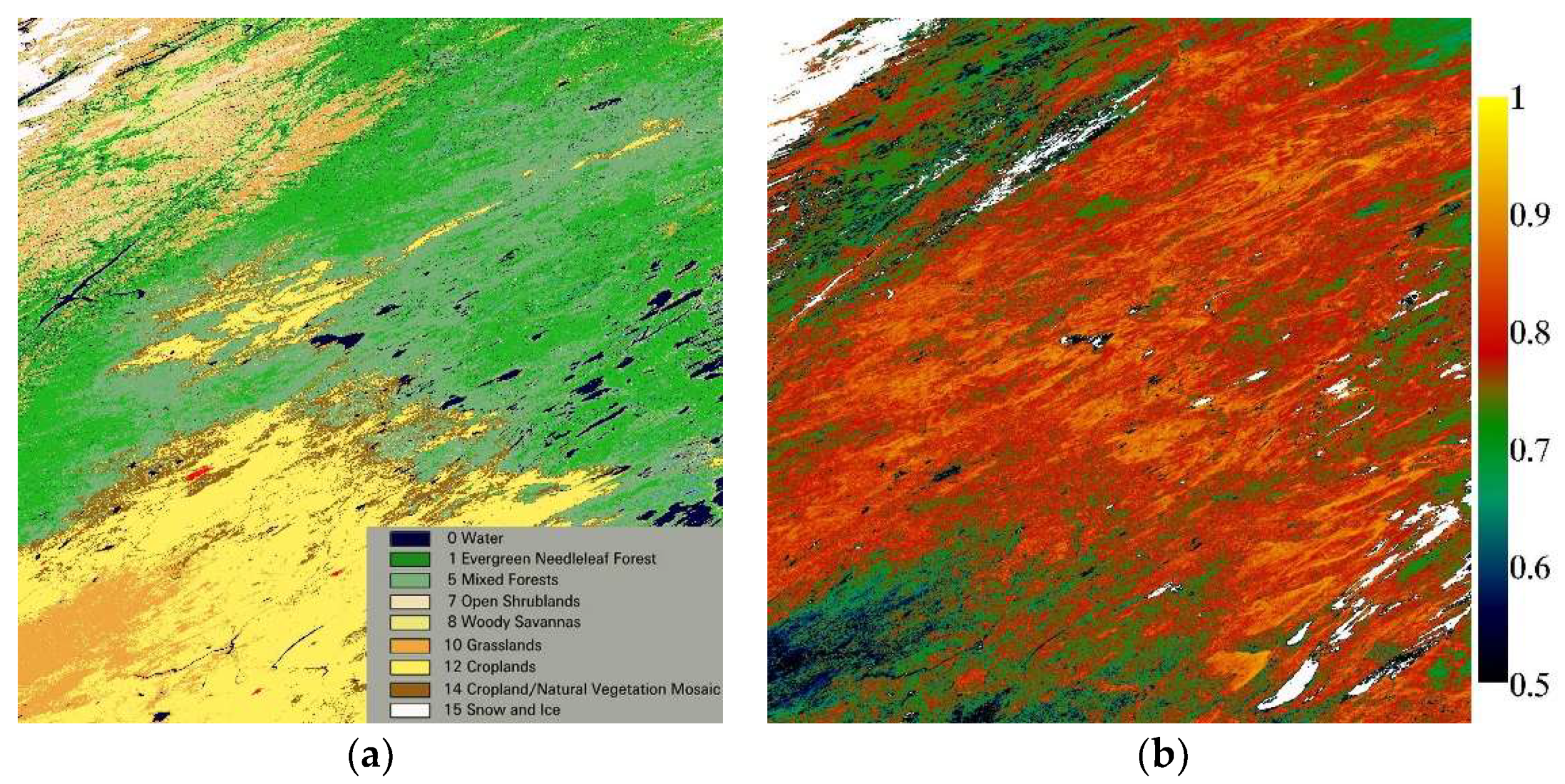
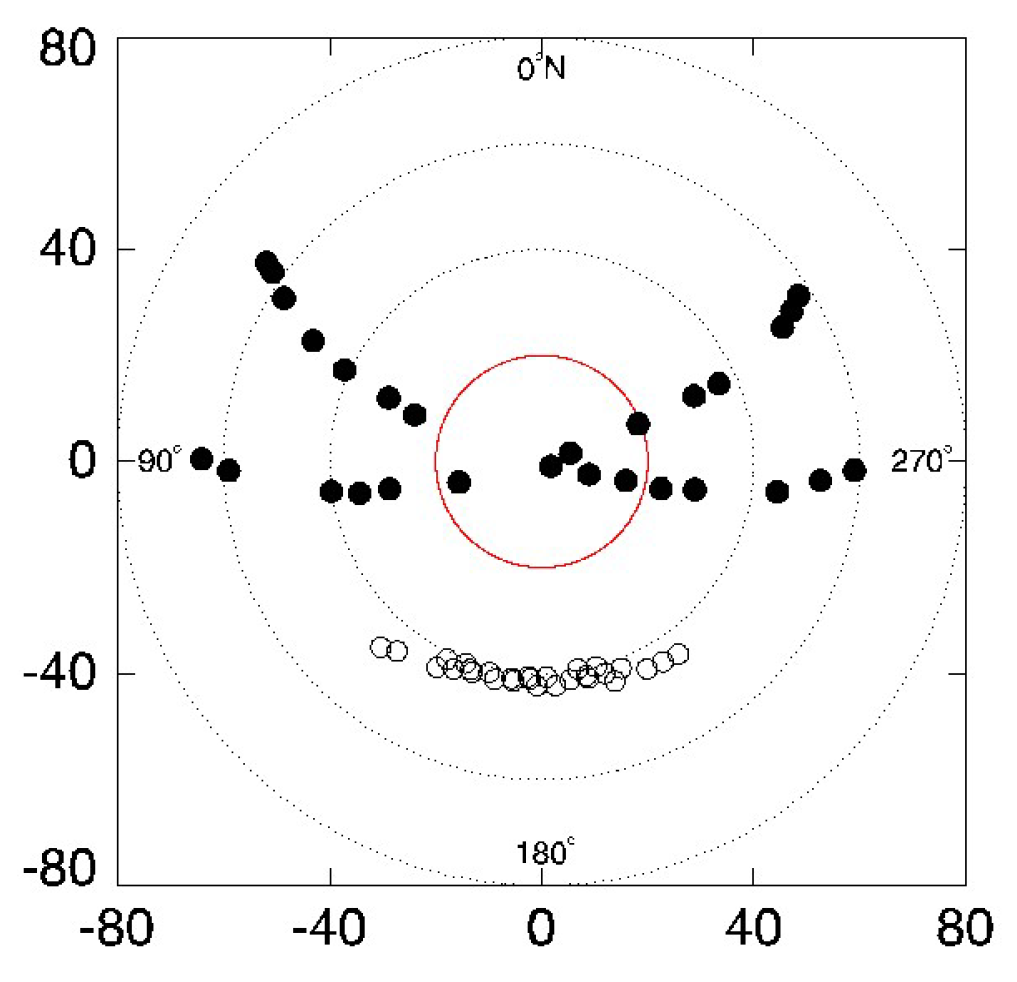
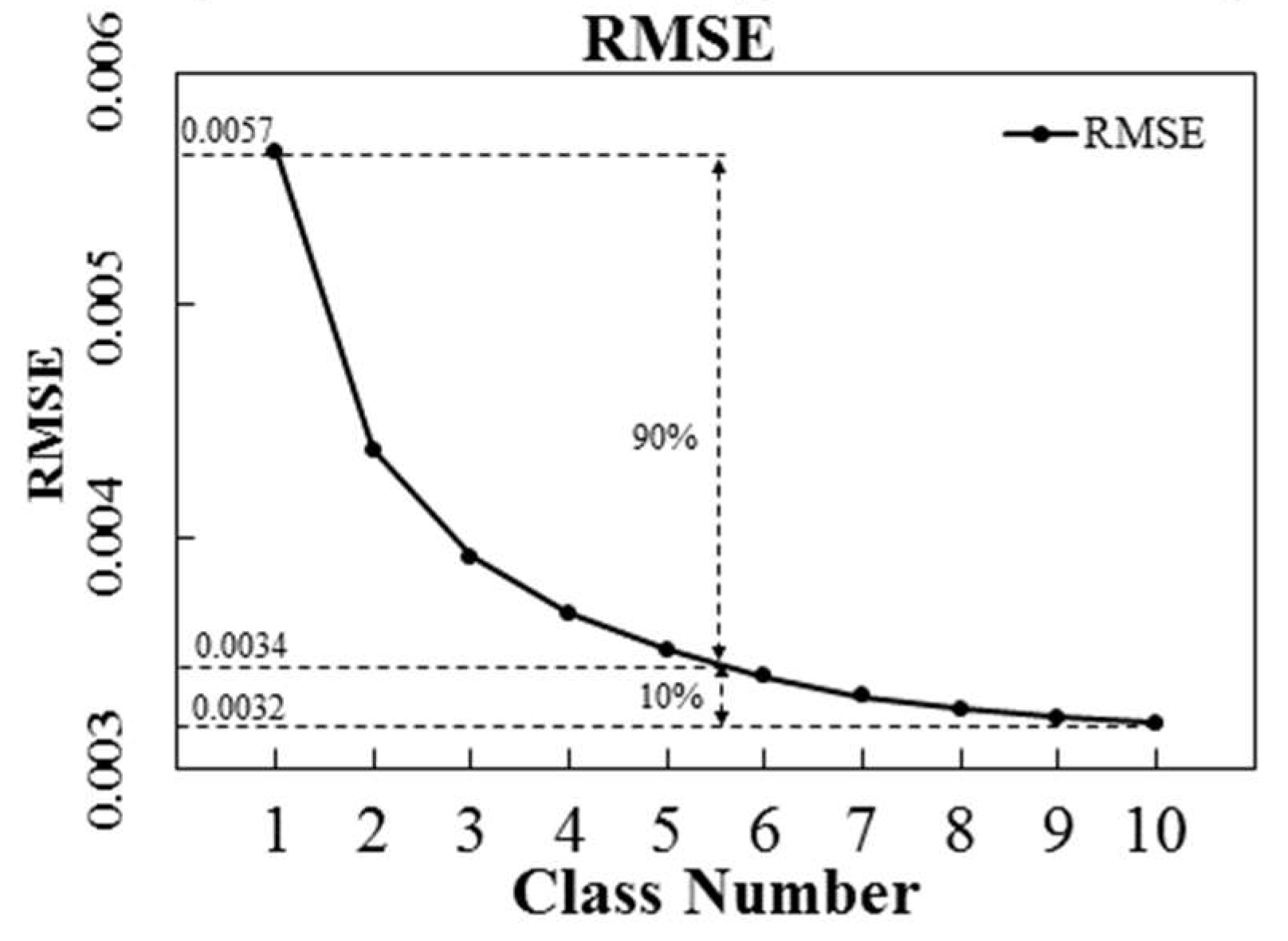
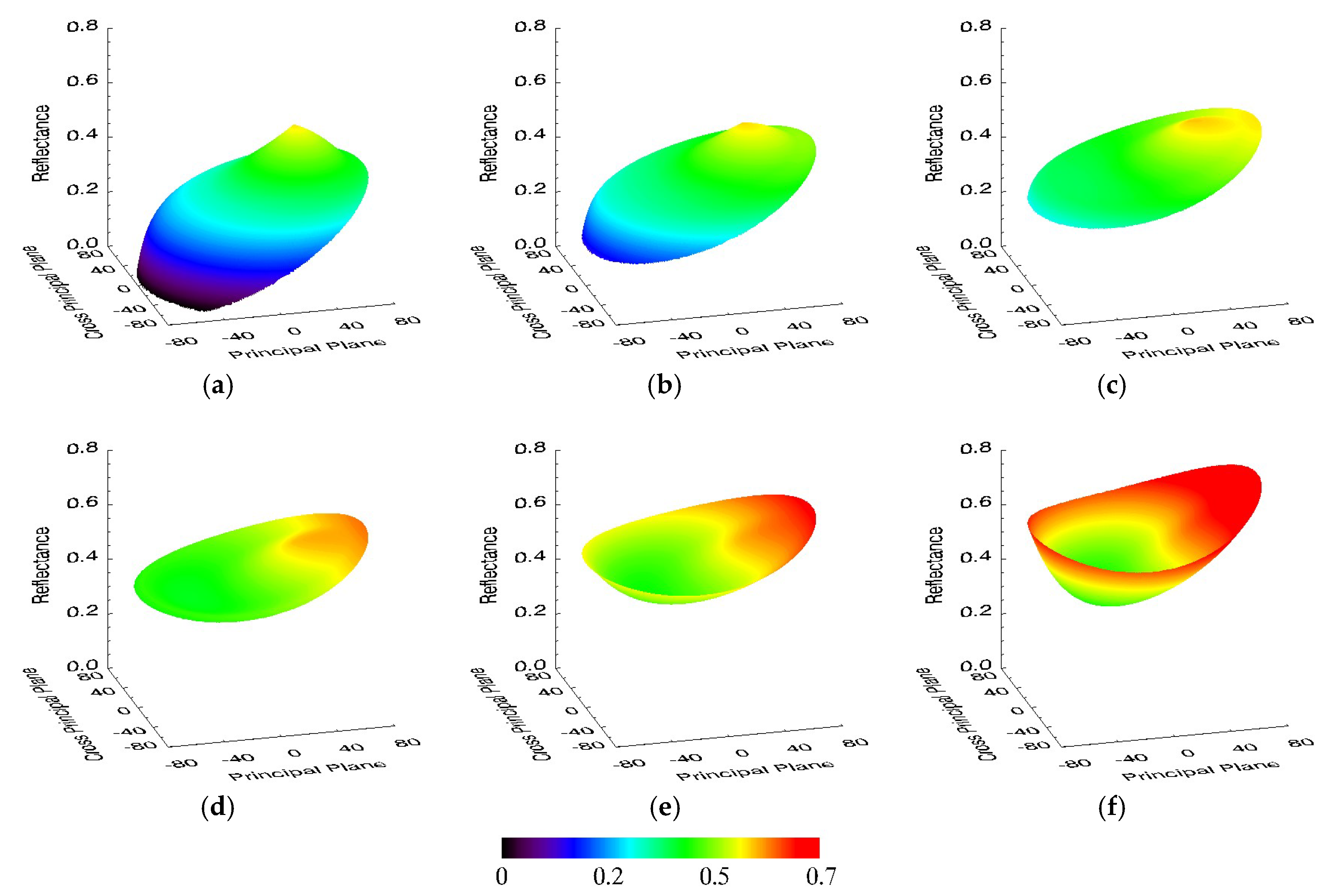
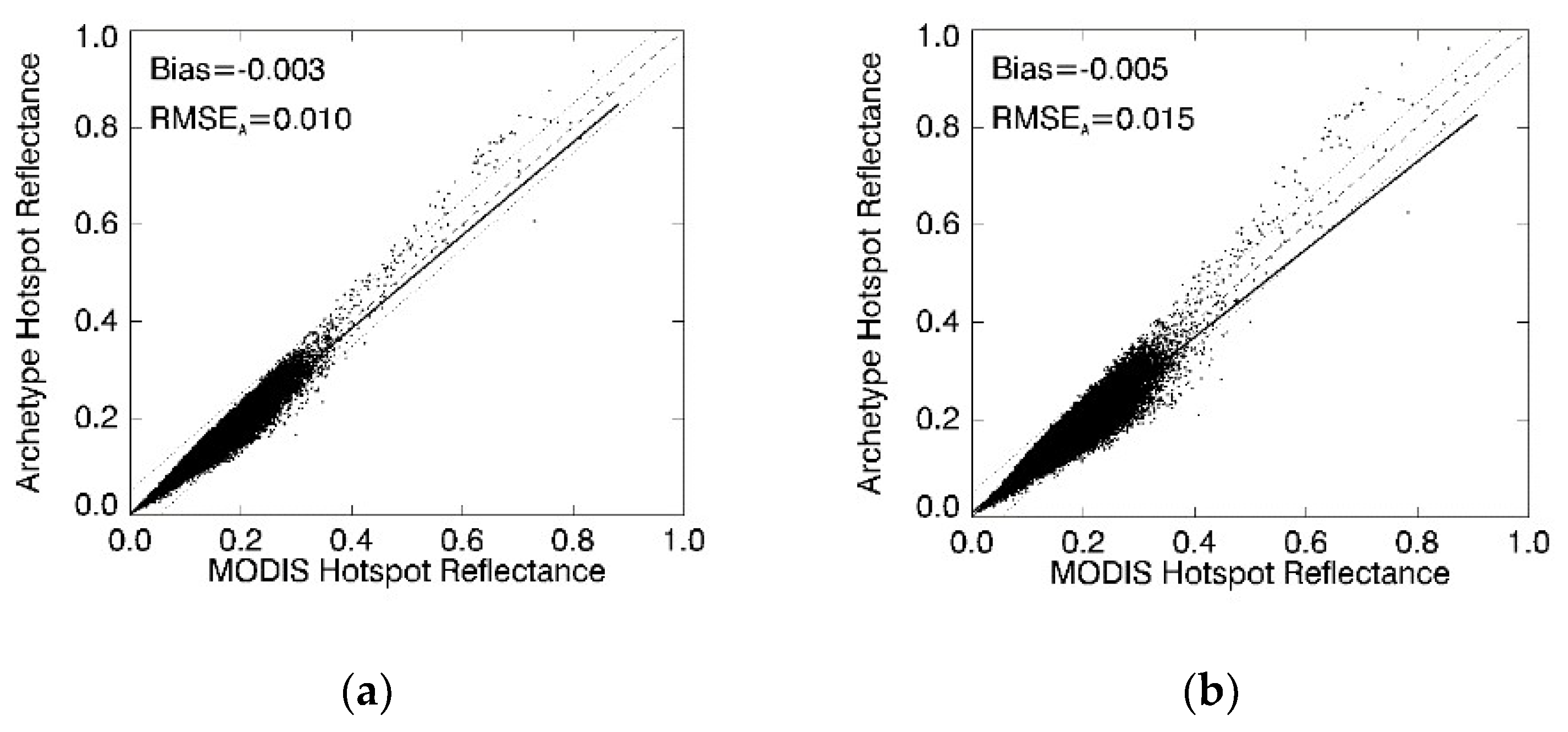



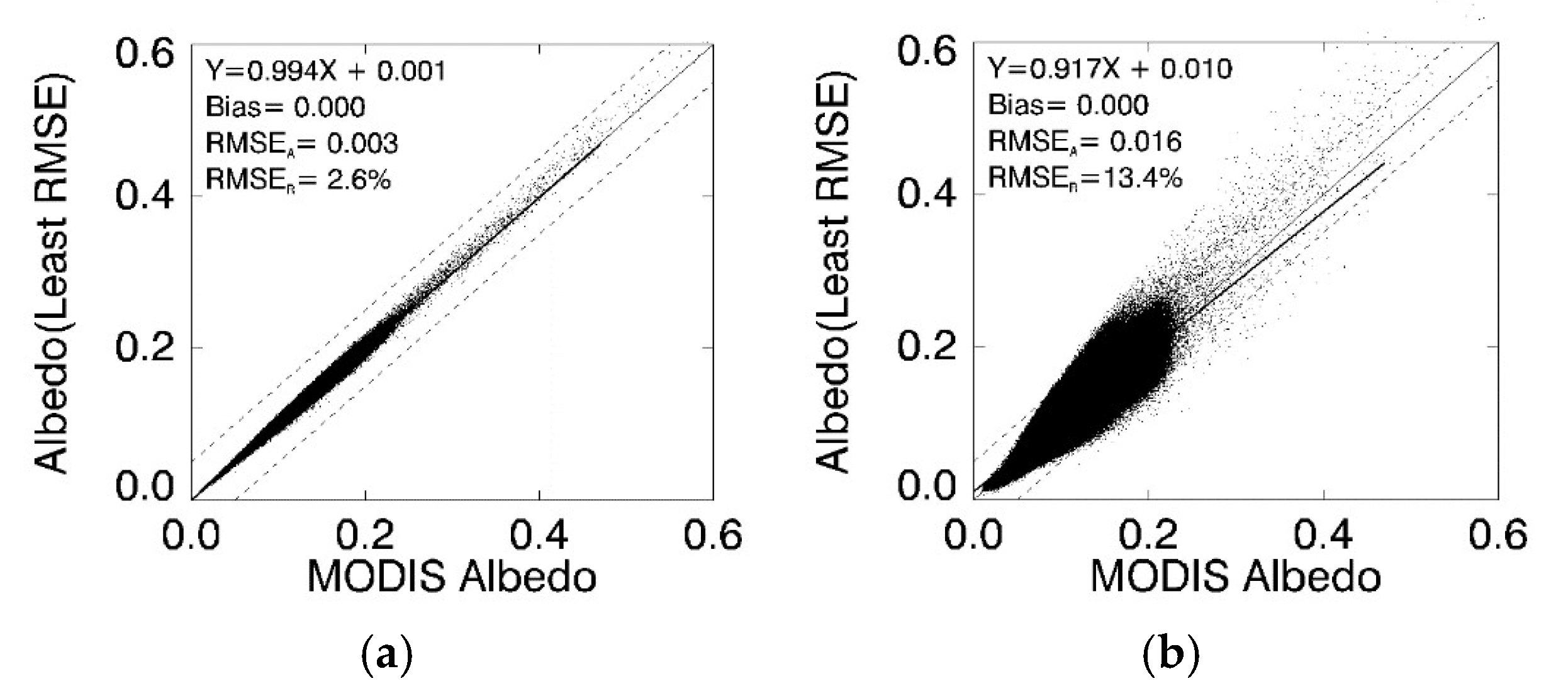
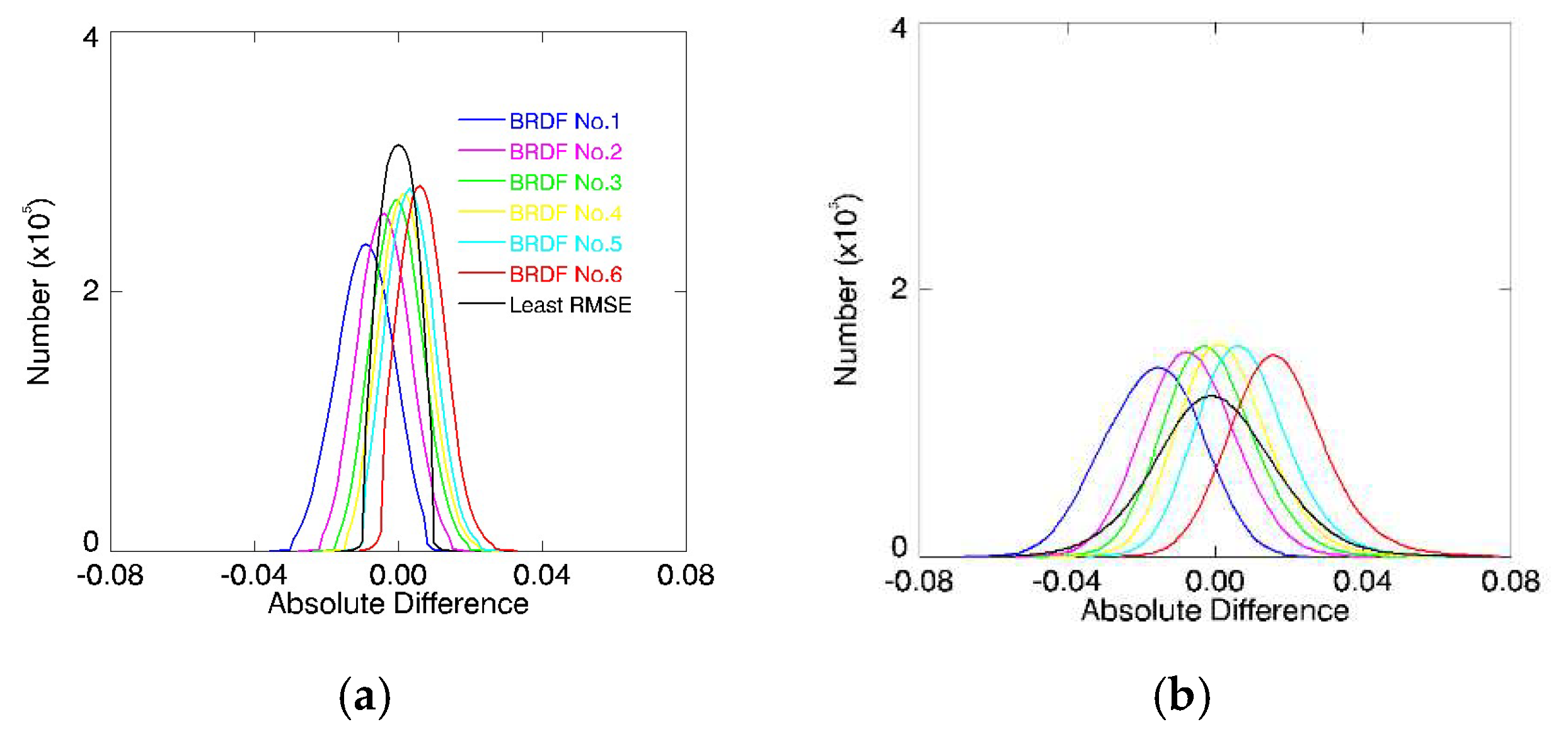

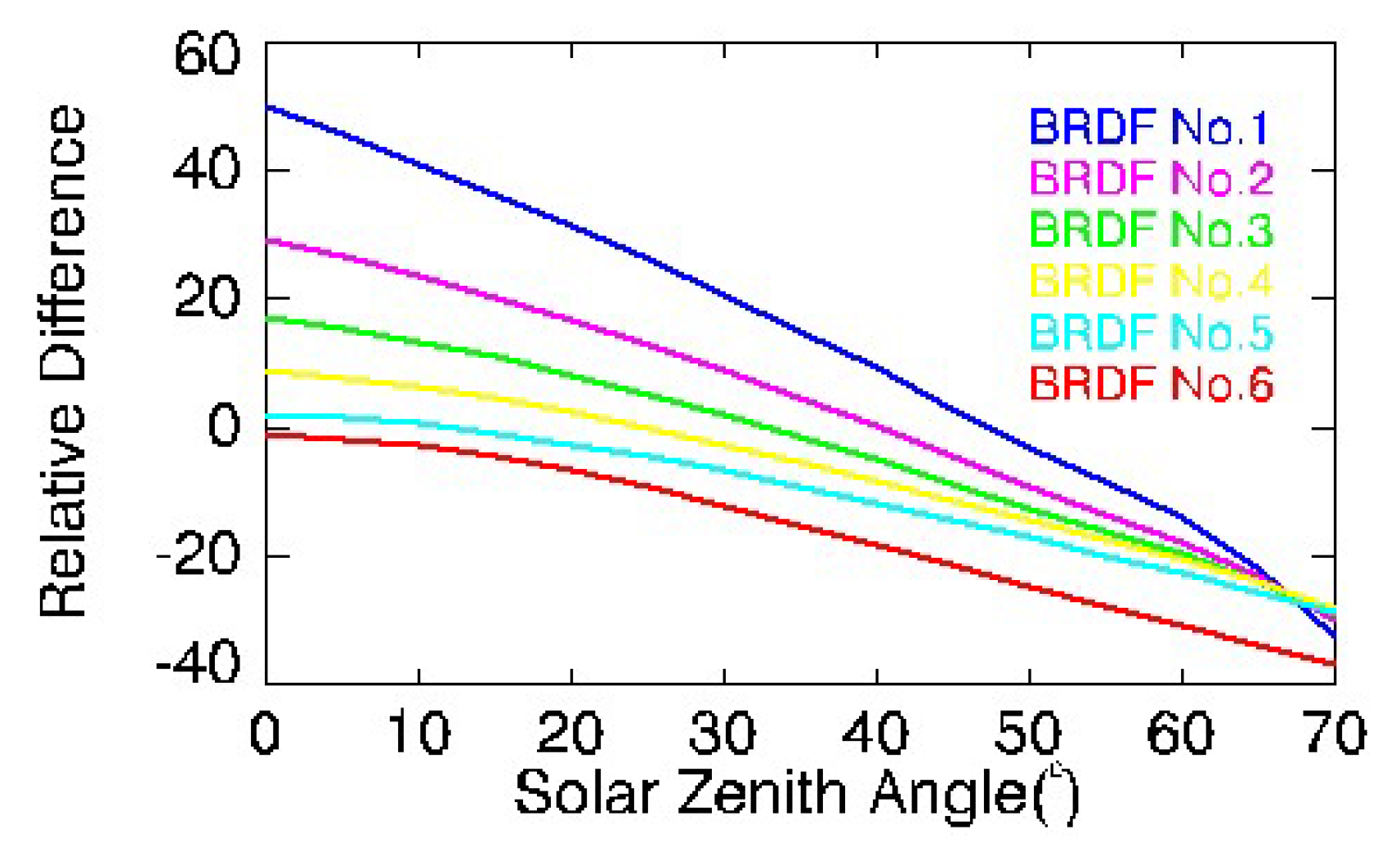


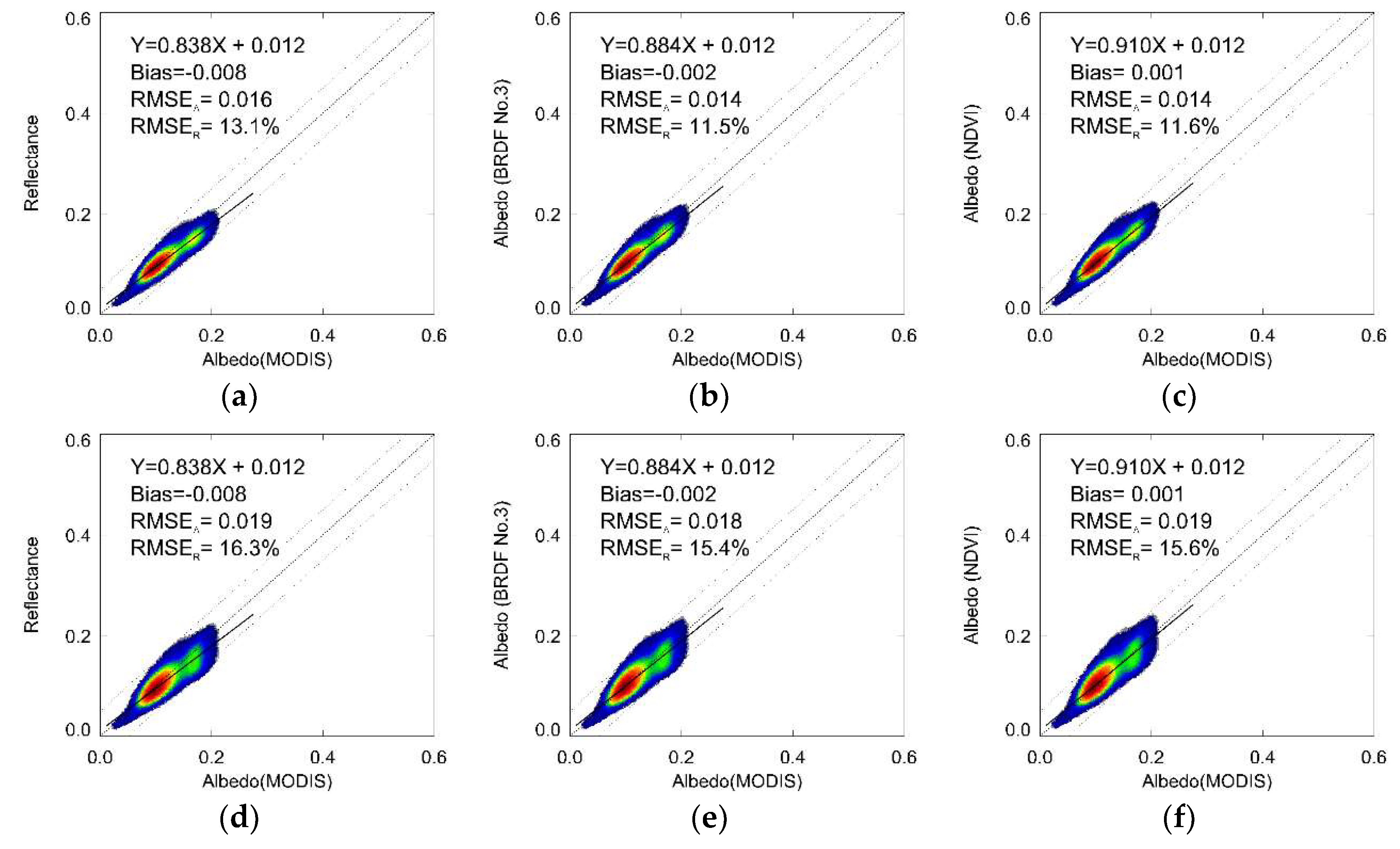


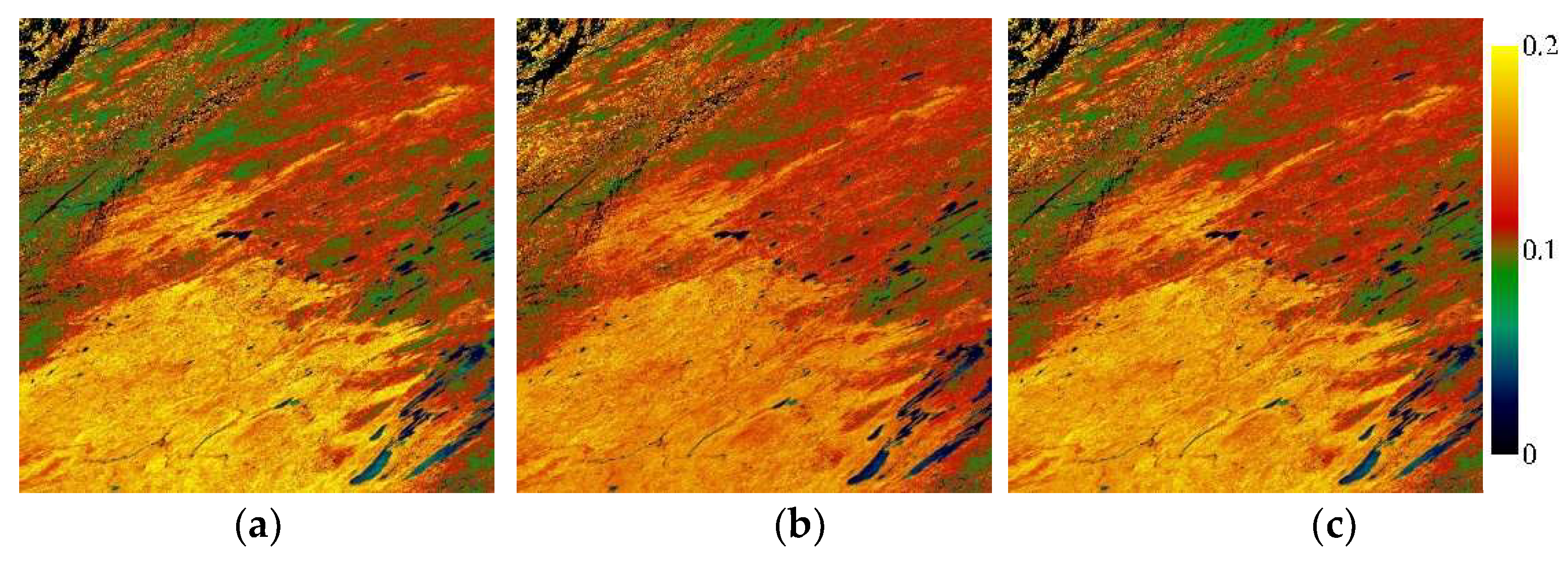
| Class | AFX Range | Fiso | Fvol | Fgeo |
|---|---|---|---|---|
| No. 1 | [0.5, 0.78] | 0.5 | 0.1392 | 0.1289 |
| No. 2 | (0.78, 0.90] | 0.5 | 0.2442 | 0.0892 |
| No. 3 | (0.9, 1.0] | 0.5 | 0.3263 | 0.0620 |
| No. 4 | (1.0, 1.09] | 0.5 | 0.3970 | 0.0392 |
| No. 5 | (1.09, 1.2] | 0.5 | 0.4927 | 0.0179 |
| No. 6 | (1.2, 1.7] | 0.5 | 0.7669 | 0.0074 |
| NDVI Range | Fiso | Fvol | Fgeo |
|---|---|---|---|
| [0.1~0.2] | 0.5 | 0.499 | 0.086 |
| (0.2~0.3] | 0.5 | 0.482 | 0.081 |
| (0.3~0.4] | 0.5 | 0.484 | 0.060 |
| (0.4~0.5] | 0.5 | 0.469 | 0.053 |
| (0.5~0.6] | 0.5 | 0.418 | 0.057 |
| (0.6~0.7] | 0.5 | 0.373 | 0.061 |
| (0.7~0.8] | 0.5 | 0.391 | 0.056 |
| (0.8~0.9] | 0.5 | 0.378 | 0.058 |
| [0.1~0.9] | 0.5 | 0.391 | 0.058 |
| Direction | Reflectance | Albedo (Arc No. 3) | MODIS Albedo |
|---|---|---|---|
| Forward 30° | 0.104 | 0.131 | 0.132 |
| Backward 30° | 0.155 | 0.129 | |
| Nadir | 0.119 | 0.130 |
© 2018 by the authors. Licensee MDPI, Basel, Switzerland. This article is an open access article distributed under the terms and conditions of the Creative Commons Attribution (CC BY) license (http://creativecommons.org/licenses/by/4.0/).
Share and Cite
Zhang, H.; Jiao, Z.; Chen, L.; Dong, Y.; Zhang, X.; Lian, Y.; Qian, D.; Cui, T. Quantifying the Reflectance Anisotropy Effect on Albedo Retrieval from Remotely Sensed Observations Using Archetypal BRDFs. Remote Sens. 2018, 10, 1628. https://doi.org/10.3390/rs10101628
Zhang H, Jiao Z, Chen L, Dong Y, Zhang X, Lian Y, Qian D, Cui T. Quantifying the Reflectance Anisotropy Effect on Albedo Retrieval from Remotely Sensed Observations Using Archetypal BRDFs. Remote Sensing. 2018; 10(10):1628. https://doi.org/10.3390/rs10101628
Chicago/Turabian StyleZhang, Hu, Ziti Jiao, Lei Chen, Yadong Dong, Xiaoning Zhang, Yi Lian, Da Qian, and Tiejun Cui. 2018. "Quantifying the Reflectance Anisotropy Effect on Albedo Retrieval from Remotely Sensed Observations Using Archetypal BRDFs" Remote Sensing 10, no. 10: 1628. https://doi.org/10.3390/rs10101628
APA StyleZhang, H., Jiao, Z., Chen, L., Dong, Y., Zhang, X., Lian, Y., Qian, D., & Cui, T. (2018). Quantifying the Reflectance Anisotropy Effect on Albedo Retrieval from Remotely Sensed Observations Using Archetypal BRDFs. Remote Sensing, 10(10), 1628. https://doi.org/10.3390/rs10101628







